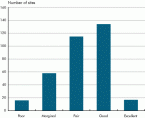What is the issue?
Water quality in Canada is under pressure from a range of sources, including human settlement, agriculture and industrial activities. Degraded water quality can affect both aquatic life and human uses of water.
What is happening?
This indicator assesses surface freshwater quality with respect to protecting aquatic life (e.g., fish, invertebrates and plants). Based on information gathered from 2002 to 2004:
- Freshwater quality at 340 selected monitoring sites across southern Canada was rated as "good" or "excellent" at 44% of the sites, "fair" at 34% and "marginal" or "poor" at 22%.
- Freshwater quality at 30 sites across Northern Canada was rated as "good" or "excellent" at 67% of the sites, "fair" at 20% and "marginal" or "poor" at 13%.
Freshwater quality measured in 2004 and 2005 in the Great Lakes was rated as “good” or “excellent” for Lake Superior, Lake Huron, Georgian Bay, and eastern Lake Erie, “fair” for central Lake Erie, and “marginal” for western Lake Erie and Lake Ontario.
Why is it important?
Good quality water in adequate quantities is fundamental to healthy ecosystems, human health and economic performance in Canada. Degradation of water quality can affect both aquatic life and human uses of water. For example, high concentrations of nutrients (e.g., nitrogen and phosphorus) may result in excessive plant growth, which reduces the amount of dissolved oxygen available for fish and other aquatic animals. Degraded water quality can also affect economic activities such as freshwater fisheries, tourism and agriculture.

Why is it happening?
Primary manufacturing and service industries, institutions and households discharge hundreds of different substances, directly or indirectly, into rivers and lakes. Many pollutants also make their way into water bodies indirectly after being released into the air or onto the land. Untreated runoff from agricultural lands and urban areas can also degrade water quality, as can changes to water flows. Natural phenomena such as glacial flows, seasonal snow melt and heavy rainfall can also lead to high levels of suspended sediments that are rich in nutrients and metals.
What’s next?
This report provides information on the status of water quality in Canada as it relates to its ability to support aquatic life. The preliminary indicator reported here will be improved in future reports.
Long-term goals for the development of the freshwater indicator include:
- a consistent and comparable set of monitoring sites that is representative of key aquatic habitats (e.g., rivers, lakes, wetlands) in Canada with respect to different beneficial uses (e.g., protection of aquatic life, agriculture, source water for drinking);
- improvements in selecting variables and guidelines used in the calculation, so that results can be aggregated regionally across the country, by drainage area and over time;
- more refined separation of the effects of natural and human-caused changes in water quality through the development of site-specific guidelines; and
- reporting on water quality for other beneficial uses, such as agriculture or raw water sources used to supply drinking water treatment plants, possibly through a series of indicators.
Monitoring
Freshwater quality monitoring capacity is limited and considerably fragmented across the country, with significant spatial gaps. Over the next few years, Environment Canada, in collaboration with provincial and territorial counterparts, will expand the current water quality monitoring network to address these spatial gaps in knowledge. This, in turn, will also enhance the national representation of water bodies and aquatic habitats throughout the country.
Indicator development
Work is being carried out on methods to improve the calculation and presentation of the current indicator, as there is a need to both compensate for the unbalanced geographical distribution of monitoring sites and present trends over time. The current geographical distribution of sites will be reviewed in an attempt to adopt a more systematic approach to selecting sites, and weights will be allocated to each of these sites. Also, a different way of compiling the indicator, possibly based on one-year versus three-year periods, will be adopted to report trends in water quality.
Health Canada initiated development of the source/raw water quality indicator in October 2005 in cooperation with a federal/provincial/territorial (FPT) working group.
Once developed, this tool is intended to provide a mechanism to evaluate source water and treated water quality, track changes and identify deteriorating or improving water quality conditions, to evaluate the effectiveness of source water protection initiatives and help guide source water protection planning and activities.
Guideline development
How well the WQI rates water quality depends directly on the use of appropriate water quality variables and guidelines. Variables and guidelines used in the WQI computation should be locally relevant, meaning appropriate to the local organisms and local water characteristics. Environment Canada, in consultation with the provinces and territories, is assessing the ecological relevance of existing guidelines with regards to local conditions and, where necessary, will develop site-specific guidelines using nationally consistent methods and protocols.
Surveys
The effect of household and industrial activities on water quality as well as the needs of households and industry for high-quality water are being documented through several new national surveys. Results from the Household and the Environment Survey will provide information on household activities that can impact water quality and changes in household behaviour in response to water quality concerns. In addition, the Industrial Water Use Survey will collect information from manufacturers, thermal power generators and mines on water use and management. A survey of municipal water treatment plants is planned, which will support the Source Water Quality Indicator. A survey of agricultural water use is also under development.







